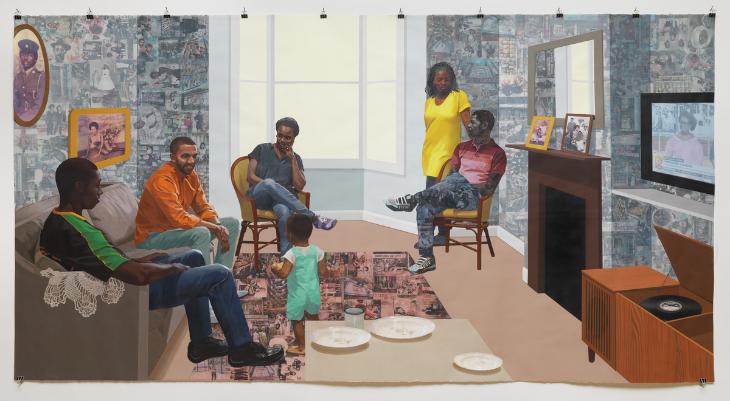By Toby Oliver- Clarke, BA History
Life Between Islands is an exhibition of grieving and gratitude: a space where protest and pacifism collide. Despite being several years in the making, the exhibition feels strikingly current, its works, some of which date back more than half a century, hold just as much importance now as they did at the time of their creation. Covering the work of over forty Caribbean-British artists, the exhibition is arranged in an order that could lazily be labeled chronological. Whilst superficially the exhibition does move from the past to the present, full engagement requires one to disregard the usual laws of time. However noble the following aims might be, the purpose of the exhibit isn’t to tell a story of black suffrage, or uncover lost static narratives of so called ‘Black history,’ but rather, the exhibit aims to create ‘living histories,’ provocations that blur the lines between then and now in the hope that we may create a better future.
This contortion of time is no more apparent than with Lubaina Himids 1987 portrait of Haitian revolutionary Toussaint Louverture. Louverture, who led the 18th century revolt of the Haitan people against colonial France, is plastered with newspaper articles covering the racist treatment of Black Britons throughout the eighties. Instantly, Himids message is strikingly clear, despite the self-congratulatory way in which race relations in modern Britain are discussed, the systemic oppression which Louverture rebelled against has not only endured, but has become an invisible shackle on the ankle of Black Britons, shackles which Himid implores us to shake off.
A room labeled ‘pressure’ bears witness to the violence, oppression and defiant joy that came to define the lived experience of Black Britons throughout the 1970s and 80s. The space is adorned with conscious contradictions. We see a rerun of Isaac Julien’s ‘Paradise Omeros,’ the now infamous film recounts the racist and often violent nature in which the Notting Hill Carnival was policed and surveilled. Directly across we see Denzil Forresters ‘Jah Shaka’ that depicts the underground black music scene that boomed during the troubled years of the 70s and 80s. The image is one of joyful rebellion, a celebration of the enduring nature of Black love and resistance. The contradictory nature of the space perfectly conveys the duality of black life throughout the late 20th Century, a reminder that only under the highest of ‘pressures’ may diamonds form.
The final room is aptly named ‘Past, Present and Future’ filled with works completed in the last few years. The space speaks to the contortion of time that runs throughout the whole exhibit. Most striking is Njidecka Akunyilis ‘Remain, Thriving,’ originally commissioned for Brixton Underground Station; the painting depicts a meeting of the grandchildren of the ‘Windrush generation.’ The scene is reminiscent of the ‘front rooms’ that many children of Afro-Caribbean descent have come to associate with their forbearers, the walls adorned with images of black revolutionaries including Olive Morris and Kwesi Johnson, serve as a reminder that we stand on the shoulders of those who struggled before us. Whilst outwardly the scene is a celebration of possibility, the painting also contains a haunting reminder. In the background, a television relays a 2018 news broadcast covering the discriminatory treatment of the Windrush generation, British Citizens of Carribean origin who were invited to come to the United Kingdom following the second World War. All at once we see the ‘Past, Present and Future’ of the black experience collide, whilst the younger generation represents the limitless future of Caribbean communities, we also see the unjust policies of the past collide painfully with our present.
“Truly a triumph of Black resistance and creativity, one could easily argue that ‘Life Between Islands’ will come to be known as the most impactful exhibit of its generation.”
‘It’s about time’ is a trope which is used amongst art critics with increasing regularity, usually used when referring to the work of artists of colour. The phrase often seems to be a way for those in the know to signal their virtue, whilst also allowing them to retrospectively seem ahead of their time. ‘Life Between Islands’ gives the phrase an entirely new meaning, with its blending of the past, present and future, the exhibit gives us both the space to conceptualize the pain of the past, whilst also providing the audience with a rallying point from which we may influence our present and the futures that lay ahead of us. Truly a triumph of Black resistance and creativity, one could easily argue that ‘Life Between Islands’ will come to be known as the most impactful exhibit of its generation. If you only see one exhibit this year, make sure it’s this one, after all, ‘it’s about time.’
‘Life Between Islands’ is at The Tate Britain till April 3rd.
Photo Caption: Njideka Akunyili Crosby, ‘Remain, Thriving’.’ (Credit: Tate Britain)
